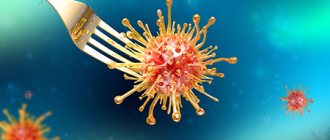Pharmacological properties of the drug Ginalgin
A drug for topical use with antifungal, antibacterial and antiprotozoal effects. The effect is due to the combined action of two components - chloroquinaldol and metronidazole. Chlorquinaldol has an antibacterial effect on gram-positive and gram-negative bacteria, antifungal, antiprotozoal and keratoplasty effects. Metronidazole has pronounced antiprotozoal activity, as well as an effect on anaerobic bacteria. When applied topically, it slightly penetrates the mucous membranes.
The use of ginalgin in gynecological practice
P
The problem of pelvic inflammatory diseases (PID) in women is one of the most pressing in obstetrics and gynecology. Despite numerous studies, the creation and use of modern antibacterial drugs, the incidence of PID is steadily increasing. This may be due, on the one hand, to the spread of sexually transmitted infections (STIs), on the other hand, to an increase in the number of invasive interventions in gynecology (cervical biopsies, polypectomies, hysteroscopies, diagnostic curettages, abortions, etc.) that promote ascendancy infections.
Patients with inflammatory diseases make up 60–65% of all gynecological patients. The main spectrum of microorganisms that contribute to the development of inflammatory diseases of the genitals: chlamydia, gonococci, trichomonas and mycoplasma. Currently, there is a tendency towards association of these pathogens. The combination of chlamydia with gonococcus is observed in 33.7% of patients, with ureaplasma - 19.1%, trichomonas - 31.3%. The cause of inflammatory diseases in 40–45% of cases is fungal infections.
STIs are often treated with multiple medications, often lasting several weeks. During this time, the effect of the drugs extends not only to the causative agents of the disease, but also to the saprophytic flora. Consequently, there is a disruption of the natural microbiocenosis of both the gastrointestinal tract and the vagina. In the latter, there is an increase in opportunistic microorganisms. It is noted that in patients with PID, polymicrobial flora is most often detected. According to V.I. Kulakova and E.M. Vikhlyaeva (1995), in the etiology of diseases of the female reproductive system, a significant role belongs to combinations of 2–6 pathogens, often with the leading role of non-spore-forming obligate anaerobic bacteria. Therefore, it seems convincing to us to include various intravaginal drugs in the complex treatment of STIs. Among them is the drug Ginalgin, which has antitrichomoniacal, bactericidal and antimycotic effects. Metronidazole, which is part of the drug, suppresses the development of anaerobic microorganisms, preventing the development of vaginal dysbiosis. Long-term, asymptomatic persistence of microorganisms is detected in 67.2% of cases. Considering this fact, it is advisable to use Ginalgin before abortions, various intrauterine interventions (insertion of an IUD, hysterosalpingography, treatment of cervical ectopia, etc.), as well as in the treatment of vaginitis caused by mixed flora and fungal vaginitis.
Another nosological entity for which the use of Ginalgin is justified is bacterial vaginosis (BV). BV is based on a violation of the vaginal microbiocenosis, characterized by a decrease in lactobacilli, an increase in the content of microorganisms in the vaginal secretion to 10 9–1011 CFU/ml with a predominance of anaerobes and an increase in the ratio of anaerobes to aerobes to 100:1–1000:1 (with a norm of 2:1– 5:1); Gardnerella vaginalis is almost always present
,
Mobiluncus
– in 50–70% of cases,
Mycoplasma hominis
– in 60–75% of cases. The development of BV, in particular, is facilitated by antibiotic therapy, changes in antibiosis between vaginal microorganisms, a decrease in the amount of H2O2 in the vaginal contents, as well as the gastrointestinal tract as a reservoir of microorganisms associated with bacterial vaginosis.
Currently, various methods of treatment for BV are offered. Thanks to the widespread introduction into clinical practice of imidazole drugs, in particular metronidazole, and the antibiotic clindamycin, great success has been achieved in the treatment of BV. Treatment for BV is carried out according to one of the following regimens:
• ofloxacin 200 mg orally 2 times a day for 5 days;
• ornidazole 500 mg orally 2 times a day for 5 days;
• metronidazole 500 mg orally 2 times a day for 7 days;
• clindamycin cream 2% 5 g (full applicator) intravaginally 1–2 times a day for 5 days.
However, with a fairly high effectiveness of these drugs, the relapse rate reaches 40–60% (Hilton E. Et all. 1995, Horowitz B., 1996), and these drugs themselves, due to their wide spectrum of action, can cause dysbiosis and be an etiological factor in the development of BV and candidal vulvovaginitis, as noted above. It has been proven that with BV, the adhesion of yeast, opportunistic and pathogenic bacteria to epithelial cells increases due to a decrease in the number of lactobacilli and a low level of sIgA, which has anti-adhesive properties, which determines the relationship between local immunity and vaginal microbiocenosis (Agikova L.A., 1996). Taking into account these data, we recommend including Ginalgin in the complex treatment of BV. The drug contains: metronidazole 250 mg, chlorquinaldol 100 mg and citric acid 20 mg. Due to this complex of medicinal substances, the drug does not have a bactericidal effect against the saprophytic flora of the vagina; chloroquinaldol, which is part of the drug, has antimicrobial, antiprotozoal and antifungal effects. Therefore, in combination with taking oral medications, the antitrichomonas effect is enhanced and has a bactericidal effect against a number of gram-positive and gram-negative bacteria. Boric acid and glucose, which are part of chlorquinaldol, and citric acid, reducing the pH of the vagina, create an optimal environment for the development of lactobacilli, thereby blocking the adhesion and growth of yeast. The spectrum of action of the drug covers not only anaerobic bacteria from the groups: Bacteroides, Fuzobacterium, Megasphera, Clostridium, Gardnerella vaginalis
, but also gram-positive micrococci, protozoa (
Trichomonas vaginalis
), yeast-like fungi (
Candida albicans
). Ginalgin is prescribed during treatment with oral medications intravaginally 1 time per day, 1 tablet at night.
In conclusion, we note the affordability of Ginalgin, its low toxicity and good tolerability, effectiveness, and the possibility of use during pregnancy and lactation, which, in turn, meets the WHO requirements for drugs for the treatment of STIs.
Ginalgin
(tradename)
(ICN Pharmaceuticals)
Indications for use of the drug Ginalgin
Vaginal infections caused by the following bacteria: Escherichia coli , Staphylococcus albus (coagulase-negative strains), Staphylococcus aureus (coagulase-positive strains), Corunebacterium diphteriae , Enterococcus , Enterobacteriacea , as well as invasion of Trichomonas vaginalis . Effective in the treatment of mixed infections caused simultaneously by bacteria, Trichomonas vaginalis and fungi.
Ginalgin tablets vag No. 10
Compound
Active ingredients: metronidazole 250 mg, chlorquinaldol 100 mg.
Excipients: anhydrous citric acid, lactose monohydrate, rice starch, sodium starch glycolate, polyethylene glycol 6000, magnesium stearate.
Pharmacokinetics
When administered intravaginally, metronidazole undergoes systemic absorption. Cmax in the blood is approximately 50% of Cmax, which is achieved after a single oral dose of metronidazole. Almost completely metabolized in the liver to form inactive derivatives.
T1/2 is 8 hours. It is excreted mainly in the urine. When administered intravaginally, chlorquinaldol is only slightly absorbed.
Indications for use
Treatment
- bacterial vaginitis;
- trichomonas vaginitis;
- fungal vaginitis;
- vaginitis caused by mixed flora.
Prevention
- before surgical treatment of gynecological diseases;
- before childbirth and abortion;
- before and after the introduction of intrauterine contraceptives;
- before and after coagulation of the cervix;
- before hysterography.
Contraindications
- Hypersensitivity to the components of the drug;
- blood diseases;
- impaired coordination of movements, organic lesions of the central nervous system (including epilepsy);
- liver failure (in case of prescribing large doses),
- pregnancy;
- breastfeeding period.
Directions for use and doses
1 vaginal tablet per day, for 7-10 days. Treatment begins 2-4 days after menstruation. The tablet should be inserted deep into the vagina, preferably in the evening before bed.
If necessary, a repeat course of treatment is possible.
Storage conditions
In a dry place, at a temperature of 15° to 25°C. Keep out of the reach of children.
Best before date
3 years. Do not use after the expiration date indicated on the package.
special instructions
During treatment with the drug, it is recommended to abstain from sexual intercourse.
If there are indications in the anamnesis of changes in the composition of peripheral blood, as well as when using the drug in high doses and/or with its long-term use, monitoring of a general blood test is necessary.
Metronidazole can immobilize treponemes, resulting in a false-positive TPI test (Nelson test).
During treatment, you should refrain from performing potentially dangerous activities that require special attention and quick reactions (driving a car, etc.).
Description
Antimicrobial combination agent.
Pharmacodynamics
Combined drug for intravaginal use. It has antibacterial, antiprotozoal and antifungal effects.
Metronidazole belongs to the nitro-5-imidazoles. Restores the 5-nitro group of metronidazole with intracellular transport proteins of anaerobic microorganisms and protozoa, which interacts with the DNA of the microorganism cell, inhibiting the synthesis of their nucleic acids, which leads to the death of microorganisms.
It is an effective antimicrobial and antiprotozoal agent with a broad spectrum of action.
Active against Trichomonas vaginalis, Giardia intestinalis, Entamoeba histolytica, Lamblia intestinalis, as well as against obligate anaerobes (spore-forming and non-spore-forming) - Bacteroides spp. (B. fragilis, B. ovatus, B. distasonis, B. thetaiotaomicron, B. vulgatus), Fusobacterium spp., Clostridium spp., Peptostreptococcus spp., sensitive strains of Eubacterium. Aerobic microorganisms and facultative anaerobes are not sensitive.
Chlorquinaldol acts on the following strains of pathogenic bacteria: Corynebacterium diphtheria, Streptococcus pyogenes, Staphylococcus aureus, Pseudomonas aeruginosa, Proteus vulgaris, Salmonella spp., Shigella spp., Escherichia coli. It is also active against protozoa: Entamoeba histolytica, Lamblia intestinalis, Trichomonas vaginalis and some fungi.
Citric acid reduces the pH of the vagina, promotes the growth and reproduction of Doderlein rods.
Side effects
Local reactions: itching, burning, pain and irritation in the vagina; thick, white, mucous vaginal discharge without odor or with a faint odor, frequent urination; after discontinuation of the drug - development of vaginal candidiasis. A burning sensation or irritation of the penis in a sexual partner;
From the gastrointestinal tract: nausea, changes in taste, metallic taste in the mouth, dry mouth, decreased appetite, cramping pain in the abdominal cavity, nausea, vomiting, constipation or diarrhea;
Allergic reactions: urticaria, itching of the skin, rash;
From the side of the central nervous system: headache, dizziness.
Other: leukopenia or leukocytosis; coloration of urine in a red-brown color, due to the presence of a water-soluble pigment formed as a result of the metabolism of metronidazole.
If any unwanted side effects occur, you should stop treatment and consult a doctor.
Use during pregnancy and breastfeeding
The drug is contraindicated during pregnancy and lactation (breastfeeding).
Interaction
Alcohol should be avoided during treatment
(similar to disulfiram, it causes alcohol intolerance).
Caution should be exercised when administered concomitantly with certain medications.
Warfarin
and other indirect anticoagulants. Metronidazole enhances the effect of indirect anticoagulants, which leads to an increase in the time of prothrombin formation.
Disulfiram.
Development of neurological symptoms (depression of consciousness, development of mental disorders), therefore Ginalgin should not be prescribed to patients who have taken disulfiram over the past two weeks.
Cimetidine
inhibits the metabolism of metronidazole, which may lead to an increase in its concentration in the blood serum and an increased risk of side effects.
Lithium preparations
the concentration of the latter in plasma increases.
The effects of Ginalgin are reduced under the influence of barbiturates
, because inactivation of metronidazole in the liver accelerates.






